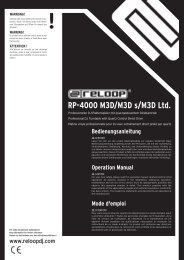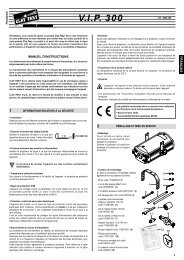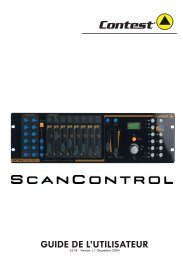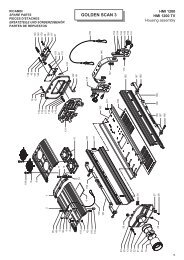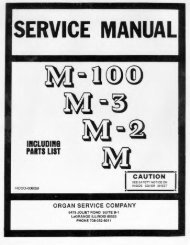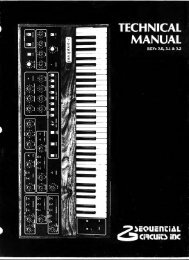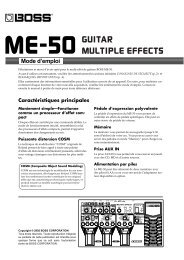Create successful ePaper yourself
Turn your PDF publications into a flip-book with our unique Google optimized e-Paper software.
The Algorithms and their ParametersBAL implements a sine/cosine balance adjustment. Balance is smoothly adjustedover a wide range, with excellent resolution in the critical area aroundzero. The display indicates the actual channel gains as the control is varied.BAL (Balance)ROT is similar to BAL, but it treats stereo information somewhat differently. Anysignal panned to the center (mono) will be treated by ROT exactly as it would betreated by BAL. However, if a signal is panned full right and the control is movedtoward the right, instead of simply being attenuated (as BAL would do) the rightchannel is inverted in phase and added to the left channel. A stereo imageappears to rotate when this control is used. Ambient information is preserved,and both channels appear to retain equal loudness.ROT (Rotate)If stereo material is recorded with a coincident pair of figure-of-eight microphones,moving the ROT slider is exactly equivalent to rotating the microphonepair. Other microphone arrays and multimicrophone setups do not rotateperfectly, but using this control is frequently preferable to simply adjustingbalance. The display shows the actual channel gains for a continually pannedsource.DLAY controls a 5-second stereo delay line, with a resolution of 10 milliseconds.Separate mono and fine controls are on the Delay page below. This is a postprocessingfull-level delay, and is always in the circuit.DLAYWhen D-Em is On, the incoming signal is digitally de-emphasized. This shouldnot be used unless the material has been emphasized in the record process—such as a PCM-F1 tape. Note that the emphasis bit in the incoming signal canbe turned off from the 300 front panel. See Chapter 2: System Operation: SetupEdit.D-EM(De-emphasis On/Off)When digital de-emphasis is applied, the CD mastering lab must be informedthat the tape is not emphasized, and the CD emphasis bit should be manuallyset to Off. Mastering labs are happy to do this, but they must be informed!When this control is on, the left channel is delayed relative to the right by 11µsec(1/2 sample). This control specifically corrects for the timing error betweenchannels caused by consumer digital systems (e.g. the Sony PCM-F1 and itsprogeny) that time-share single analog converters. Turning on this delay timealigns the left channel audio data for compatibility with professional systems.11 µsec (1/2 sample)RFnS is used for digitally correcting probelms you used to be able to fix (orcreate) by switching analog cables around. The normal setting is +L to the leftoutput and +R to the right output. Other settings should only be used whencorrecting some problem created previously in the recording process.+L+R = Normal Routing+L-R = Right Channel polarity inverted (flipped)+R+L = Left and Right Channels swapped-R+L = Right flipped and swapped with LeftRFnS (Right ChannelFlip 'n' Swap)4-19





